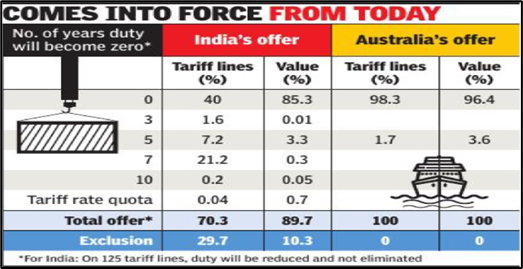In News:
- The India-Australia Economic Cooperation and Trade Agreement (ECTA) comes into force from today.
- The aim of this agreement is to double the bilateral trade to $50 billion in five years and ease movement of people, goods and services across borders.

What’s in today’s article:
- India-Australia Bilateral Relation
- News Summary
India-Australia Bilateral Relation: In Brief
- India and Australia established diplomatic relations in the pre-Independence period, with the establishment of India Trade Office in Sydney in 1941.
Strategic Relationship
- In 2009, India and Australia established a ‘Strategic Partnership’, including a Joint Declaration on Security Cooperation.
- This cooperation has been further elevated to Comprehensive Strategic Partnership (CSP) in 2020.
- The Australian foreign policy blueprint released in November 2017 sees India in the front rank of Australia’s international partnerships.
- In order to pursue the CSP, Foreign and Defence Ministers of both countries agreed to meet in a ‘2+2’ format biennially.
Economic and Trade Relationship
- As part of its efforts to develop strong economic relationship with India, the Australian Government commissioned the India Economic Strategy to 2035 in July 2018.
- This was done to define a pathway for Australia to unlock opportunities offered by Indian Economic growth.
- Bilateral Trade:
- India had a trade deficit of $8.5 billion with Australia in FY22, with $8.3 billion worth of exports and $16.8 billion worth of imports.
- Total bilateral trade is expected to cross $45-50 billion in five years from $ 5 billion at present after the free trade deal comes into force.
- India was the 8th largest trade partner of Australia with trade in goods and services representing 3% share of the total Australian trade in FY 2019-20.
Civil Nuclear Cooperation
- A Civil Nuclear Cooperation Agreement between the two countries was signed in September 2014 during the visit of then PM Tony Abbott to India.
- The agreement provides the framework for substantial new trade in energy between Australia and India.
Defence Cooperation
- During PM Modi's visit to Australia in November 2014, both sides decided to extend defence cooperation to cover research, development and industry engagement.
- Arrangement concerning Mutual Logistics Support (MLSA) and Implementing Arrangement concerning cooperation in Defence Science and Technology were concluded during the Virtual Summit held in June 2020.
- India and Australia conduct their bilateral naval exercise 'AUSINDEX' since 2015.
- In 2018, Indian Air Force participated for the first time in the Exercise Pitch Black in Australia.
- In October-November 2020, the Australian Navy participated in Malabar Exercises.
Repatriation of Indian Cultural Artifacts:
- A number of artifacts have been successfully repatriated to India in recent years. They include:
- Bronze Idol of Nataraja from Art Gallery of South Australia (AGSA) (2019),
- Nagaraja stone sculpture (2020),
- two Dwarpala stone sculptures (2020).
News Summary
- The India-Australia ECTA comes into force from today. The trade deal is seen to be strategic given the increased engagement between the two countries in recent years.
- In April 2022, India and Australia signed an Economic Co-operation and Trade Agreement (ECTA).
Significance of ECTA For Australia
- Many analysts described the ECTA as an antidote for Australia’s China trouble as it will give exporters duty-free access to India.
- India is the second-largest market after China.
- In 2020, China punished Australia economically after the Canberra government supported an international inquiry into the origins of Covid-19.
- Since then, Australia has witnessed sustained trade sanctions from its top trading partner, China.
Significance of ECTA For India
- Labour-intensive sectors
- The major boost would be in its labour-intensive sectors, which are currently subject to import duty of 4-5% by Australia.
- Now, it will gain immediate duty-free access.
- Manufacturing sector
- Exports of textiles and apparel, leather and footwear, furniture, sports goods, jewellery, machinery, railway wagons and select agricultural and marine products are seen to be the top beneficiaries in addition to pharma.
- Australia is the largest importer of garments in the southern hemisphere.
- While China’s share of import of apparel into Australia is more than 70%, India’s share in imports is less than 5%.
- With the ECTA getting operationalised, India will have a slight duty advantage over Vietnam and Indonesia for imports in the Australian market.
- Power sector
- Coal accounts for three-fourths of Indian imports from Australia.
- LNG, alumina, and manganese are other vital imports. The Indian power sector will gain from cheaper coal.
- Service sector
- There are major gains on the services side too.
- Australia has committed to facilitate India’s services in IT, ITeS, business services, health, education and audio-visual, among others.
- It has agreed to provide a post-study work visa of 2-4 years for Indian students and a work and holiday visa for youth.
- It has also offered a quota for entry of 1,800 Indian chefs and yoga teachers.










